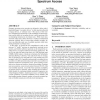Free Online Productivity Tools
i2Speak
i2Symbol
i2OCR
iTex2Img
iWeb2Print
iWeb2Shot
i2Type
iPdf2Split
iPdf2Merge
i2Bopomofo
i2Arabic
i2Style
i2Image
i2PDF
iLatex2Rtf
Sci2ools
IMC
2010
ACM
2010
ACM
On the feasibility of effective opportunistic spectrum access
Dynamic spectrum access networks are designed to allow today's bandwidth hungry "secondary devices" to share spectrum allocated to legacy devices, or "primary users." The success of this wireless communication model relies on the availability of unused spectrum, and the ability of secondary devices to utilize spectrum without disrupting transmissions of primary users. While recent measurement studies have shown that there is sufficient underutilized spectrum available, little is known about whether secondary devices can efficiently make use of available spectrum while minimizing disruptions to primary users. In this paper, we present the first comprehensive study on the presence of "usable" spectrum in opportunistic spectrum access systems, and whether sufficient spectrum can be extracted by secondary devices to support traditional networking applications. We use for our study fine-grain usage traces of a wide spectrum range (20MHz
| Added | 13 Feb 2011 |
| Updated | 13 Feb 2011 |
| Type | Journal |
| Year | 2010 |
| Where | IMC |
| Authors | Vinod Kone, Lei Yang, Xue Yang, Ben Y. Zhao, Haitao Zheng |
Comments (0)

